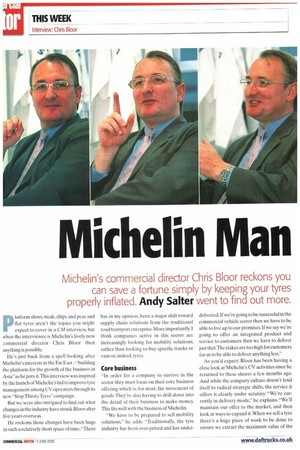Michelin Man
Page 24

Page 25

If you've noticed an error in this article please click here to report it so we can fix it.
Michelin's commercial director Chris Bloor reckons you can save a fortune simply by keeping your tyres properly inflated. Andy Salter went to find out more.
platform shoes, steak, chips and peas and fiat tyres aren't the topics you might expect to cover in a CM interview, but when the interviewee is Michelin's lively new :ommercial director Chris Bloor then anything is possible.
He's just back from a spell looking after Michelin's interests in the Far East -"building the platform for the growth of the business in Asia" as he puts it.This interview was inspired by the launch of Michelin's bid to improve tyre management among CV operators through its new -Stop Thirsty Tyres" campaign.
But we were also intrigued to find out what changes in the industry have struck Bloor after live years overseas.
He reckons those changes have been huge in such a relatively short space of time: "There has, in my opinion, been a major shift toward supply chain solutions from the traditional road transport enterprise. More importantly,! think companies active in this sector are increasingly looking for mobility solutions, rather than looking to buy specific trucks or vans or, indeed, tyres.
Core business
"In order for a company to survive in the sector they must focus on their core business offering which is. for most, the movement of goods. 'They're also having to drill down into the de tail of their business to make money This fits well with the business of Michelin.
"We have to be prepared to sell mobility solutions," he adds. "Traditionally, the tyre industry has been over-priced and has under delivered. If we're going to be successful in the commercial vehicle sector then we have to be able to live up to our promises. If we say we're going to offer an integrated product and service to customers then we have to deliver just that.The stakes are too high for customers for us to be able to deliver anything less."
As you'd expect, Bloor has been having a close look at Michelin's CV activities since he returned to these shores a few months ago. And while the company culture doesn't lend itself to radical strategic shifts, the service it offers is clearly under scrutiny. "We're currently in delivery mode," he explains. "We'll maintain our offer to the market, and then look at ways to expand it. When we sell a tyre there's a huge piece of work to be done to ensure we extract the maximum value of the product on behalf of the customer."
Which brings us conveniently to tyre management and the ways in which truck and van operators can ensure they're not throwing fuel away through their rubber. A recent survey by Michelin showed that a staggering 60% of trucks are running on tyres which are under inflated by at least 10% .That equates to a massive 124 million litres of fuel being wasted at a cost of £100m. In an industry which is constantly fighting for every penny of profitability, that's a mind boggling amount of money to throw away.
The logic is simple enough, as Bloor explains: "If you've ever tried to push a car with a flat tyre you'll have felt the full effect of increased rolling resistance, and moreover, the amount of energy required to overcome it. Now that's an extreme case, but even a 10% reduction in pressure from the recommended levels will hit your fuel economy by 1.5%.
"A lot of people don't appreciate that approximately one third of the energy in every litre of fuel burnt by the engine goes on overcoming the rolling resistance of the tyres. The rest goes on overcoming the frictional forces in the engine and the aerodynamic drag. There's been plenty of attention to improved aerodynamics and low friction lubricants, yet the tyre is often overlooked.
Raise awareness "The purpose of Stop Thirsty Tyres is to raise awareness of the fact that there are sound business reasons for applying good tyre husbandry to your fleet." Pressure and alignment are the two mair offenders when it comes to tyres; bott affect fuel efliciency and wear rates unlesi they are set correctly.
Michelin recommends a daily visua check of the tyres and, at the very least, E monthly pressure test. Laser alignment 01 axles should be carried out on an annua. basis.
To Michelin's credit the Stop Thirsty Tyre. campaign isn't restricted to a plug for its own products. The company does claim that on a spec-for-spec basis its tyres have a lower rolling resistance than its competitors, but its campaign website (www.stopthirstytyres.com) offers sound best-practice advice which every transport operator would do well to put into practice.
As the Michelin research indicates, that's not currently the case. The sooner it is, the sooner truck and van operators can ensure they are extracting the maximum value from the vehicles they operate. •






































































































































































































